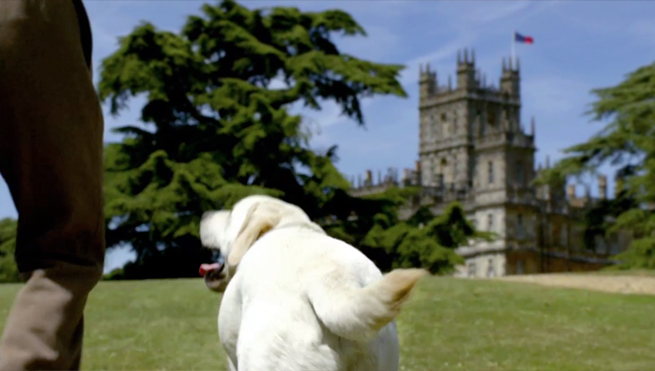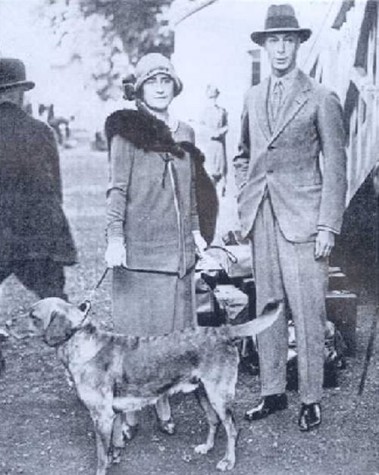WARNING: If you are not up-to-date on the most recently aired episode of Downton Abbey on PBS, and you actually care what happens, read no more. Spoiler, though hardly a shock, within.
“I’m worried about Isis,” Downton Abbey’s Lord Grantham told his daughter Mary the other night. “She’s not looking too clever.” ‘Tis true: Isis, the yellow Labrador Retriever whose ample rear end has long graced the opening credits of the show, is about to die. It’s nothing to do with the recent and awkward association of her name with Islamic terrorism, though: Isis has lived at least eight years since she appeared as an adult dog in Season Two. She has lived through the Great War, the Spanish flu, and Matthew Crawley’s histrionic car crash; she has lasted longer than some of the series’ devoted viewers. Isis has simply grown old.
Not that we aren’t sad to see her go. When Lord Grantham carried Isis into the bedroom wrapped in a blanket and settled her down on the bed next to his wife—the dog’s impending death mending the rift that had yawned between the couple for the last few episodes—I actually cried. But not much, really, and not for long. Because not only has Isis done quite well by the standard of yellow Labrador movie stars, expiring with less cloying indignity than Marley and less violence than rabid Old Yeller (actually a yellow Lab/Mastiff cross), Isis is also a perversely modern dog, and one that I never considered quite real.
This past weekend, I hung out at the San Diego Labrador Retriever Club’s annual breed show in Valley Center, California, where Labrador dogs like Isis competed for top honors in contests based mostly on looks. Under the broad shade of oak trees on an 80-degree weekend, roughly every third dog was an Isis: Sweet-faced, of yellow coat, a little bit daft, and, frankly, quite chubby. Later, over lunch with six hardened Labrador fanciers, five of them women, I asked who’d seen Downton Abbey. “I love that show!” said one woman, a breeder from Kalispell, Montana. But would the Crawleys have had a dog like Isis? “No, probably not,” she said. Isis was too stocky—and the wrong color. “If there were any yellow labs,” she added, “they’d be that color,” pointing to the butterscotch flowers on the shirt worn by the lone man at the table. “Or even red.”
By most accounts, the Labrador retriever has its origins in the St. John’s Dog, a working water dog once common in Newfoundland. A full century before Downton, the hypergraphic waterfowl hunter Colonel Peter Hawker wrote in his diary that he’d possessed one, named him Tiger, and loved him like mad. On the unfortunate day that the dog succumbed to a “violent distemper” and had to be shot, he described him: “quite black, and with a long head, very fine action,” possessed of “good temper, high courage,” and “excellence in shooting for the fields.” In the dog’s honor, he paraphrased Hamlet: “We shall not look upon his like again.”
Perhaps not, but plenty of breeders have tried to create his like again, and some have probably come close. In 1815, when the second Earl of Malmesbury needed a good bird dog for his ornithology pursuits, he imported a few St. John’s dogs from Newfoundland and began breeding his own line—selecting, no doubt, for fine heads and high courage. At the same time, the fifth Duke of Buccleuch was importing “Little Newfoundlands” to aid in hunts on his Scottish estate. By the 1880s, Malmesbury’s heirs had lost interest in hunting, and Buccleuch’s dogs had all died off, so the third Earl of Malmesbury gave the sixth Duke of Buccleuch six carefully bred “Labrador” dogs—Malmesbury’s term—to begin the family’s kennel anew. According to the late trainer and historian Richard Wolters, those six black dogs are the ancestors of all modern Labs.
Pictures of Buccleuch’s early Labs show lean, game dogs whose short coats repelled not only water but ice. Virtually all of them were black. Until 1899, when Major C. Radclyffe registered his yellow Ben of Hyde with the U.K. kennel club, light-colored coats were deemed a fault and breeders culled puppies born with them. And Radclyffe’s “yellow” meant almost dark gold.
Isis’s creamy coat and cultivated physique diverges from those ancient lines. But she departs somewhat from the modern breed standard, too, in ways that cast harsh light on beauty-contest dog shows. The world of purebred dogs is rife with examples of dogs whose care and breeding values the opinions of show-ring judges over function in the field, the obedience ring, or even just a backyard game of fetch. At the Westminster Dog Show this week in Madison Square Garden, pugs trotted around the ring with snouts are so squished they can hardly breathe. Bulldog bitches notoriously gestate puppies with heads too big to whelp without surgical intervention. I’ve known some breed-champion terriers that lack the drive to tree a squirrel, much less go-to-ground after a rat; some prize-winning retrievers, one of my tablemates told me, just plain won’t retrieve.
So it is with Labs: Sometime in the last couple of decades, the Labs in the show ring got fat. The Kalispell breeder’s friend, a woman whose chocolate Lab grew up too small to compete in the show ring, resented it. She’d read an article in Gun Dog magazine that described early Labs so light and compact they could ride in the bow of the boat. “These dogs here today would tip a boat over!” she said. Everyone laughed.
How this happened, and why, no one seems to know. The best answer I got at the Lab show was “judges like fat Labs.” But nobody else seems to—not my lunch companions, not the Midwestern duck hunters who prize their agile water dogs, not even the keepers of the breeding books. The Labrador Retriever Club, Inc., better guardians of the breed standard, apparently, than any kennel club in any country, wrote a stern letter to the American Kennel Club last April, imploring judges to remember that the Labrador retriever should possess an “athletic, well-balanced conformation that enables it to function as a retrieving gun dog.”
Or to guide the blind, calm traumatized veterans throughout their jittery days, wow crowds in dock-diving contests, retrieve felled ducks from lakes for their hunters, and search in the rubble for both the living and dead. There’s the other rub with Isis: As far as I can tell, the darn dog never even got to hunt. Downton’s wranglers brought in fox hounds, harriers, springer spaniels and black Labs for that. If Isis wasn’t looking too clever on her death bed, maybe it’s because she never got much of a chance to look clever at all.
Poor Isis! She died in such beloved company, but lived without much purpose. That’s the final anachronism: Among England’s aristocrats between the wars, a lazy Lab kept for show by the fireside would have been odd indeed. The fantasy dog named Isis may have enjoyed a long and comfortable life, but for a dog presumably bred to fetch ducks from icy rivers, it couldn’t have been much fun.
Top photo: Isis, on her way out. Courtesy PBS.
Bottom photo: Prince Albert and his wife Elizabeth Bowes-Lyon with their “yellow” Lab in the 1920s. Wikimedia Commons.

